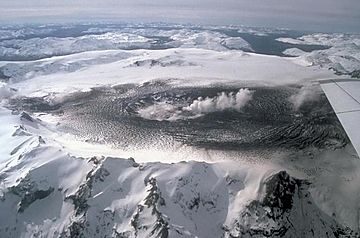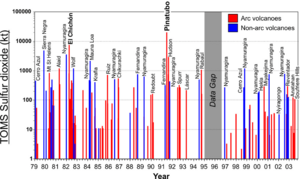Mount Hudson facts for kids
Quick facts for kids Mount Hudson |
|
|---|---|
| Cerro Hudson | |

Aerial photo from 1991
|
|
| Highest point | |
| Elevation | 1,905 m (6,250 ft) |
| Naming | |
| Etymology | Named after Francisco Hudson |
| Geography | |
| Location | Chile |
| Parent range | Andes |
| Geology | |
| Mountain type | Stratovolcano |
| Volcanic arc/belt | Southern Volcanic Zone |
| Last eruption | 2011 |
Mount Hudson is a huge volcano in southern Chile. It's also known as Volcán Hudson or Monte Hudson in Spanish. This mountain had one of the biggest volcanic eruptions in the 1900s!
Mount Hudson is covered by a glacier, which is like a giant river of ice. At the very top, there's a huge bowl-shaped crater called a caldera. This caldera was formed by a super old eruption. Today, any new volcanic activity happens inside this big crater. The volcano is named after Francisco Hudson, a Chilean explorer from the 1800s who mapped the seas.
Contents
Mount Hudson's Fiery Past
Mount Hudson has erupted many times over thousands of years. Scientists have found evidence of very powerful eruptions that happened long ago. For example, around 6,700 years ago, a huge eruption (called "H1") might have affected people living in the area. Another big eruption around 3,900 years ago (called "H2") spread ash as far as the Falkland Islands, which are more than 1,200 kilometers (about 750 miles) away!
More recently, Mount Hudson had smaller eruptions in 1891 and 1971. It also had a very large eruption in 1991.
The 1971 Eruption
Before the 1970s, not much was known about Mount Hudson. In 1970, some small eruptions started. These eruptions melted parts of the glacier, causing river levels to rise. This helped scientists discover the volcano's caldera.
In August and September 1971, a moderate eruption happened. Ash shot into the air, and a lot of the glacier melted. This caused dangerous mudflows, called lahars, to rush down the mountain. Sadly, these mudflows caused tragic loss of life, and many people had to leave their homes for safety.
The Powerful 1991 Eruption
The eruption from August to October 1991 was incredibly powerful. It was a type called a plinian eruption, which means it shot a huge column of ash and gas high into the sky. This eruption blasted out about 4.3 cubic kilometers (over 1 cubic mile) of material!
Again, parts of the glacier melted, creating more mudflows. Because the area is very remote, no one was killed, but hundreds of people were evacuated. Volcanic ash fell over parts of Chile and Argentina, and even reached the South Atlantic Ocean and the Falkland Islands. One person described how the ash was up to 15 centimeters (6 inches) deep in some places. The ash caused big problems for farms, especially for sheep, because it made the ground muddy and sticky. Many farms were left empty years later.
Besides ash, the eruption also released a lot of sulfur dioxide gas and tiny particles called aerosols into the atmosphere. These gases, along with those from another huge eruption (Mount Pinatubo) earlier that year, helped cause a worldwide cooling effect for the next few years. The eruption also affected the ozone layer, making the Antarctic ozone hole grow to its largest size ever recorded in 1992 and 1993.
Because the Mount Pinatubo eruption happened just before, Mount Hudson's eruption didn't get as much attention, even though it was very significant.
The 2011 Eruption
On October 26, 2011, Chilean authorities issued a red alert. This meant they feared an eruption was coming soon, and people living nearby were evacuated. The eruption happened on October 31. Luckily, it was a small eruption and didn't cause any damage to the area.
See also
 In Spanish: Volcán Hudson para niños
In Spanish: Volcán Hudson para niños



